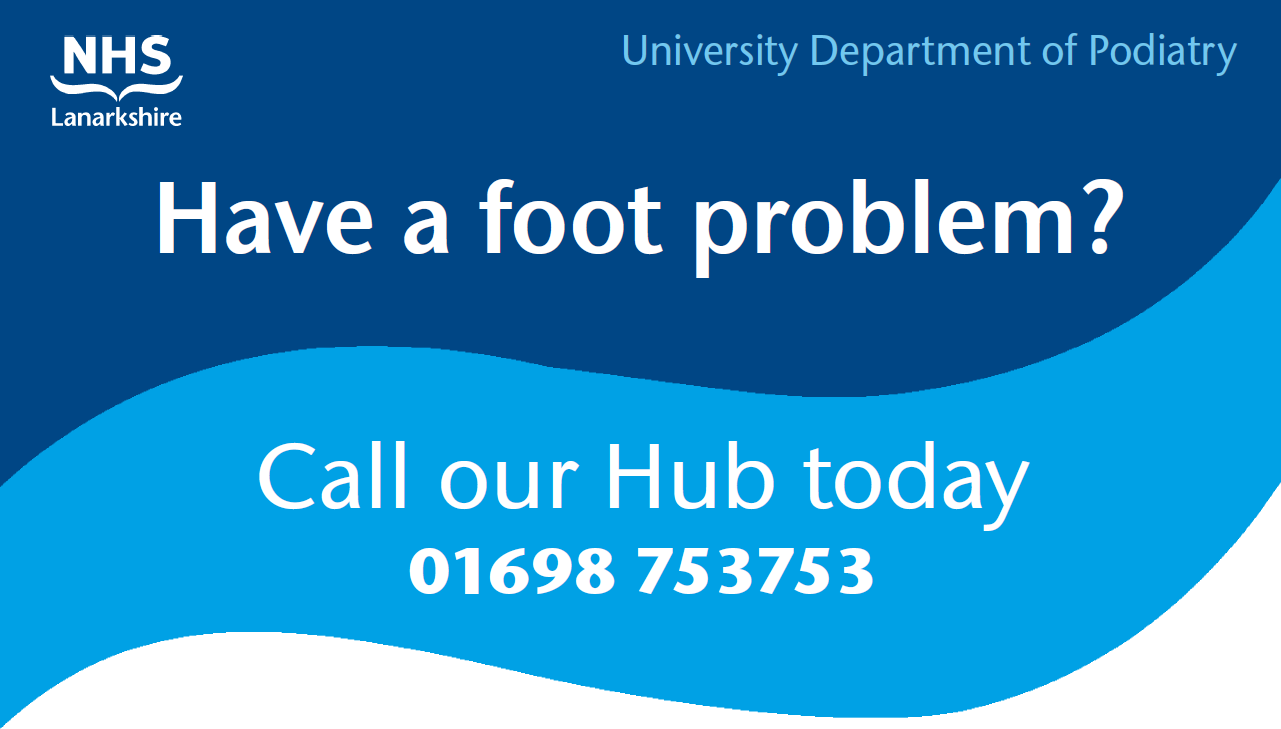Footwear Advice
University Department of PodiatryWhy does footwear matter?
There are 26 bones in each foot and walking helps keep the surrounding muscles and ligaments strong and flexible. In an average lifetime, we walk around 100,000 miles, which is the equivalent of five times around the earth.
The footwear that you choose to wear can either help you to maintain a healthy pain-free foot or cause increased stress and pressure which can aggravate your foot pain. Poorly fitting footwear can also significantly increase your risk of falls or injury.
Advice on buying new shoes
Some people think that their feet stay the same size throughout their whole life. Over the years your feet will naturally change shape and can increase in length and width so it is useful to have your feet measured when buying new shoes.
Buying an expensive shoe does not mean that it will be a better shoe; there is no guarantee that it will offer you any more support, comfort, or be a better fit than a less expensive shoe.
Most people tend to have one foot slightly bigger than the other, so always try both shoes on to make sure that they both fit well and are comfortable.
A correctly fitting shoe will feel comfortable from the start and in the main should not require “breaking in”.
What makes a good supportive shoe?
When buying shoes it is important that you always consider the fit and the function of the shoe.
How to check shoe fit
A shoe with a good fit will determine how comfortable it is. You can help ensure the shoe is the correct length, width and depth for your foot by:
- Maintaining a thumbs width between the end of the shoe and your longest toe
- Wearing a shoe that is rounded at the front and deep enough to allow your toes room to move
- Wearing a shoe that fits comfortably and snugly around your heel. This helps to stabilize the heel as the shoe strikes the ground. You should also be able to insert your finger between the back of the shoe and your heel
- Wearing a shoe with an adjustable fastening like laces, straps with buckles or Velcro. This will help hold your foot firmly in place and reduce friction.
- The ideal shoe should a thick, shock-absorbing, non-slip rubber sole with a heel gradient of no more than 1 ½” (4cm)
- A shoe with a curve at the forefoot region is known as a rocker or toe spring and can be beneficial in reducing strain in the tissues in your feet during the propulsive phase of walking
- Wearing shoes that are made from natural fibres or breathable synthetic materials that allows moisture to evaporate, the upper should be soft with no hard seams or ridges
Function
It is important that you wear the right shoe for the activity that you are participating in. The function of the shoe is how the design of the shoe enables or restricts the movement within your foot and ankle. For example, if you are going running you should wear a shoe that has been specifically designed for running, wear a ballet shoe for ballet, a tap shoe for tap dancing and so on.
Party shoes (fashion shoes) were designed for special occasions and not for everyday use. To avoid developing foot problems or aggravating existing problems, save your party shoes for special occasions!
Work footwear if you wear safety footwear for health and safety, it is the duty of your employer to provide these. If you are having problems with the comfort of safety footwear, or they do not have the features your clinician recommended, speak to your employer to see if they can provide alternative footwear; ask your clinician for further advice if they can’t.
What makes a shoe unsuitable?
- Very soft flexible shoes will offer no support to your foot and ankle. This can make tired, sore muscles, tendons and ligaments work even harder
- A shoe with a thin, hard sole, will not provide enough cushion or shock absorption for your foot
- A “slip-on”, or court shoe causes your toes to curl and grip the shoe to keep it on when walking; this can lead to the development of hard skin and corns on the tops and tips of your toes. This can lead to damage of your joints and deformity of your toes
- A shoe with a pointed toe box squashes your toes together. This can lead to the development of hard skin and corns on the tops and tips of your toes and over prominent bones like bunions. This can eventually lead to damage of your joints and deformity of your toes.
- A high heel shoe will cause the forefoot to be pushed down into the end of the shoe. This increases pressure through the ball of the foot, it can also lead to the development of hard skin and corns on the tops and tips of your toes and over prominent bones like bunions. This can eventually lead to damage of your joints and deformity of your toes.
- Shoes made of plastic or rubber are not breathable and will cause your foot to sweat
- Don’t persist with a shoe that is uncomfortable
Other things to consider
Insoles
You may be prescribed insoles or orthoses as part of your treatment. These may be in the form of a simple heel pad or a complex device that alters the way your foot functions. In order for the treatment to be successful, it is very important that you wear a shoe that can accommodate the insole.
The shoe should have:
- Increased depth at the toe and heel
- An adjustable fastening
- No more than 1 ½” (4cm) heel height
- Or a removable insole that will allow easy accommodation of the prescribed orthoses
Wear and tear
Always check your shoes are in good condition and replace them whenever there are signs of wear and tear that can’t be repaired. Signs can include:
- Soles can be worn, cracked and loose. This can lead to a loss of grip and increase your risk of falls or injury
- Rough edges of the seams or linings can increase friction on prominent joints or toes and result in blisters, callus, corns or ulceration
- Softening of the heel counter causes the shoe to lose its shape, the shoe will not be as snug around your heel. The shoe will become less supportive and your foot will begin to slip in the shoe
Socks, stockings and tights
To maintain good foot hygiene always change your socks, stockings or tights every day. Ensure that they are the right size for your feet. Socks that are too small are just as harmful as shoes that are too small. They should not have bulky seams which can cause irritation and increase friction. Do not wear socks, stocking or tights with holes in them.
Diabetes
Footwear which does not fit properly is one of the most common causes of foot wounds in people with diabetes. The development of foot wounds in people with diabetes is serious and is linked to an increased risk of heart attack, stroke, amputations of the foot or leg and early death. View our diabetes footwear advice leaflet to view further information on diabetic footwear.
Condition-specific advice
Bunions
It is important that you choose footwear that is wide enough to accommodate the deformity. It can also be useful to choose a shoe that has a softer material as the upper. Softer materials can mould easier than hard patent leathers.
If your shoe is too narrow it will rub on the prominent joint causing the surrounding skin can become red, swollen and in some cases, the skin can blister or become thickened. Sometimes a fluid-filled sac, called a bursa, can develop over the joint. The bursa can also become inflamed and painful.
Stiff painful big toe (hallux rigidus)
It is important to be aware that your big joint may not bend enough to accommodate being in certain shoes, high heeled shoes, in particular, can increase strain through the big joint.
Some people find it more comfortable to wear a stiffer sole shoe with a curve at the forefoot region. This feature is known as a rocker or toe spring and is beneficial in reducing strain in the tissues in your feet during the propulsive phase of walking.
Lesser toe deformities
It is important that you choose footwear that is deep enough to accommodate any hammer toe or clawing deformities. It can also be useful to choose a shoe that has a softer material as the upper. Softer materials can mould around the toes easier than hard patent leathers. If your shoe is not deep enough, it will rub on the prominent joints causing the surrounding skin to become red, swollen and in some cases, the skin can blister or become thickened. Sometimes fluid-filled sacs, called a bursa, can develop over the joint. The bursa can also become inflamed and painful.
Ball of foot pain (metatarsalgia, Morton’s neuroma)
This is possibly due to some inflammation and swelling in the foot; it is advisable to avoid shoes that have thin, hard soles. These types of shoes will not provide enough cushion or shock absorption for your foot. Some people benefit from wearing a thicker soled shoe that offers more shock absorption, such as a running style trainer. It is also advisable to avoid shoes that are pointed as they compress your forefoot and aggravate your symptoms. A shoe with a wider toe box can help reduce your symptoms.
Fat pad syndrome
This is possibly due to some inflammation and swelling in the heel. It is advisable to avoid shoes that have thin, hard soles. These types of shoes will not provide enough cushion or shock absorption for your foot. With the reduced ability of the heel to shock absorb, some people find benefit wearing a thicker soled shoe that offers more shock absorption, such as a running style trainer.
Heel (Haglund’s) bumps
Shoes that have a stiff heel counter have less flexibility which can aggravate the skin overlying heel bumps. This can cause the surrounding skin to become red, swollen and in some cases the skin can blister or become thickened. Sometimes a fluid-filled sac, called a bursa, can develop over the bump. The bursa can also become inflamed and painful. A shoe with a softer heel counter may help this condition.
If the advice on our website hasn't helped or improved your foot issue, you can self-refer and book an appointment.
Please complete our e-referral form and email this form to podiatry.hub@lanarkshire.scot.nhs.uk
The Podiatry Hub is open from Monday to Friday from 8am to 6pm.


NHS Lanarkshire Psychological Services: Digital Resources
Information for GPs and staff in all mental health services
Related Content
Footwear Companies that provide wider and deeper footwear include:
Your Feedback – comments, concerns and complaints
NHS Lanarkshire is committed to improving the service it provides to patients and their families. We therefore want to hear from you about your experience. If you would like to tell us about this please visit our feedback page.


